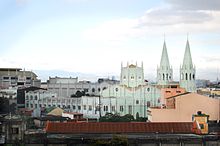Basílica de San Sebastián (Manila)
Coordinates: 14 ° 36 ' N , 120 ° 59' E
The Basílica de San Sebastián is a minor basilica of the Roman Catholic Church in the capital of the Philippines , Manila . It is in Plaza del Cármen , at the eastern end of Claro M. Recto Street, in the Quiapo district . It is administered by the order of the Augustinian recollects in their order province of St. Ezekiel Moreno. The basilica was declared a National Heritage Site of the Philippines by former President Ferdinand Marcos in 1973. Since 2006 she is on the list of proposals of the Philippines for inclusion on the World Heritage List of UNESCO .
The Basílica de San Sebastián is the only sacred building in Asia that was built entirely from steel in the neo-Gothic style . The architect of the basilica was the Spaniard Genero Palacios . Companies from Belgium , Germany and the Philippines were involved in the construction.
history
The basilica had three previous buildings. The first dates from 1621 and was financed by Don Bernardino Castillo. It was a wooden church that was destroyed by an earthquake in 1651 . The next church building dates from 1800. It was built from stone and inaugurated in 1850. However, it was destroyed again in the great earthquake of 1859. The next attempt started in 1880, but was canceled that same year after an earthquake destroyed the bell tower that had already been built .
As a result, the priest, commissioned by the order, Esteban Martinez, looked for a way of building an earthquake and fire-proof building. He found it in the self-supporting metal frame construction developed by Gustave Eiffel in Europe . Eiffel had already drafted a steel cathedral in 1875, but could not find a client for this plan. Eiffel's construction principles and his design of the steel cathedral were the model for the construction of the Basílica de San Sebastián.
architecture
The executive architect Genero Palacios had already gained experience in Spain with the then new type of construction. He created an architectural design that contained various stylistic elements: the outside area was designed in the neo-Gothic style, the inside area in the baroque style. The construction drawings for the building were completed in 1883. However, it took another five years to raise the necessary funds and select the suppliers for the building materials. Construction of the basilica began in 1888 and ended in 1891 with the inauguration on August 15.
Filipino artists were hired for the interior work. The glass paintings come from the German company Glasmalerei Oidtmann . The steel elements were manufactured in Belgium by the Société Anonyme des Entreprises de Travaux Publiques in their steelworks in Binche and transferred to Manila in nine shiploads. The marble used for the interior work comes from the Romblones archipelago . There are a total of six marble baptismal fonts in the basilica.
restoration
The Basílica de San Sebastián was restored in 1982 by experts from the National History Museum of the Philippines. Because of the warm and humid climate on the island of Luzon , the repair work to protect the steel structure is very complex and must be repeated in short periods of time. Due to the permanent lack of money of the owner and the lack of support from the state, the necessary repair work could not be carried out in the 1990s, so that the basilica was declared one of the 100 most threatened cultural monuments in the world by UNESCO in 1998. As a result, the order of the Augustinian recollects was able to obtain the necessary financial means through donations and finance the maintenance and repair of the basilica.
See also
Other major churches in the Philippines
- Cathedral Basilica of the Immaculate Conception (Manila Cathedral)
- Basilica of the Black Nazarene
- Basilica of St. Lorenzo Ruiz
- Basilica of Our Lady of Peñafrancia
- Menor ng San Miguel Arkanghel Basilica
- Basilica ni San Martin ng Tours
- Santo Domingo Church
gallery
Catheter near the main altar






